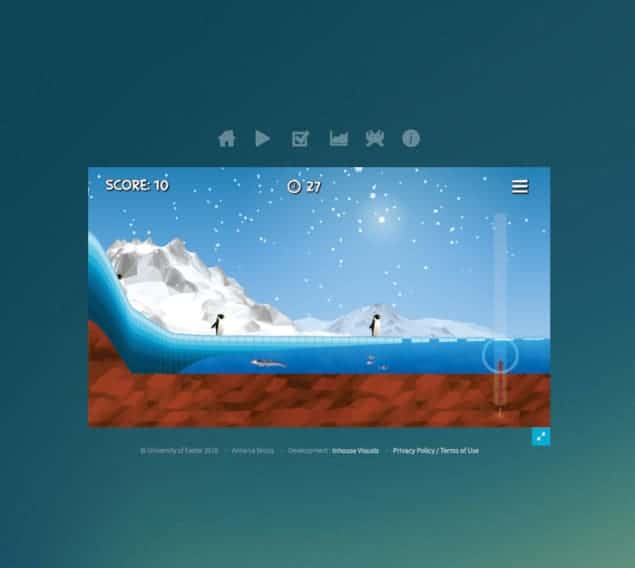URL: www.iceflowsgame.com

So what is the site about?
Computer and video gamers of a certain vintage will have fond memories of Lemmings, a game in which players must shepherd pixelated, suicidal rodents around a series of obstacles to reach safety. At first glance, the Ice Flows game is strikingly similar. Your task is to guide hungry penguins to their feeding grounds off the Antarctic coast, ensuring that they leap into the water in the precise place where the fish are, and the leopard seals aren’t. But that’s where the likeness ends. In Lemmings, any resemblance between the playing environment and actual lemming habitat was purely accidental (and in any case, real-world lemmings don’t walk off cliffs). Ice Flows, by contrast, is grounded solidly in science. The design of each game level is based on actual locations, and to steer your penguins to the right place, you must manipulate the rate of snowfall onto their icy breeding grounds and the temperature of the waters beyond them. What’s more, the effects of changing snowfall and water temperature are based on detailed data and computer models of real ice-shelf behaviour.
Who is behind it?
Ice Flows is the brainchild of Anne Le Brocq, a physical geographer at the University of Exeter, UK, who studies ice sheet modelling and the sub-glacial hydrology of ice sheets. She created the game with two game developers, Inhouse Visuals and Questionable Quality, and with support from the British Antarctic Survey and researchers at several other institutions around the UK and Europe. The whole effort was funded by the Natural Environment Research Council.
What’s it like to play?
The developers have crafted a cute and visually appealing game around the flowing-ice concept, and striking the right balance between snowfall and water temperature is pleasingly tricky without ever tipping into frustration. An initial tutorial level is followed by more difficult scenarios based on the Ronne and Filchner ice shelves. In some of these later levels, the complex interplay between the ice and the shape of the bedrock below it means that even a small increase in water temperature will cause your entire ice shelf to break up into icebergs, sending your penguins straight into the jaws of the waiting leopard seals. Such behaviour is physically realistic. According to in-game explanations, when the bedrock slopes downwards inland, it is known as a “reverse slope” and “there is a theory that once an ice sheet starts to retreat down a reverse slope, it is harder to stop the retreat”.
Who is it aimed at?
The game’s visuals and its reward element (when you perform well you accumulate credits that you can use to “buy” fancier types of penguins) seem tailor-made for children in late primary/early secondary school. With a couple of exceptions, most of the levels look and behave very similarly (presumably because there isn’t that much variation in the real locations), so in pure gameplay terms, the scientific realism of Ice Flows is actually something of a hindrance. That said, the game is certainly good enough to use as part of a lesson on climate change, and the “about” page has links to a number of useful resources for teachers. Finally, as Le Brocq points out in the game’s blog, video snippets from the game make excellent visual aids in public lectures about ice science.
- Enjoy the rest of the November 2016 issue of Physics World in our digital magazine or via the Physics World app for any iOS or Android smartphone or tablet. Membership of the Institute of Physics required



